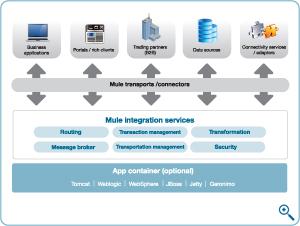technology

Mule ESB
Mule ESB™ is the world's most widely used open source ESB (enterprise service bus)
Mule ESB is a lightweight Java-based enterprise service bus (ESB) and integration platform that allows developers to connect applications together quickly and easily, enabling them to exchange data. Mule ESB enables easy integration of existing systems, regardless of the different technologies that the applications use, including JMS, Web Services, JDBC, HTTP, and more.
The key advantage of an ESB is that it allows different applications to communicate with each other by acting as a transit system for carrying data between applications within your enterprise or across the Internet. Mule ESB includes powerful capabilities that include:
- Service creation and hosting — expose and host reusable services, using Mule ESB as a lightweight service container
- Service mediation — shield services from message formats and protocols, separate business logic from messaging, and enable location-independent service calls
- Message routing — route, filter, aggregate, and re-sequence messages based on content and rules
- Data transformation — exchange data across varying formats and transport protocols
 | An ESB functions as a transit layer for carrying information, providing connectivity to a wide range of heterogeneous technology assets. The bus provides a set of capabilities to enable integration and service-oriented architecture (SOA), including service creation and mediation, routing, data transformation, and management of messages between endpoints.
|
Do I need an ESB?
Mule and other ESBs offer real value in scenarios where there are at least a few integration points or at least 3 applications to integrate. They are also well suited to scenarios where loose coupling, scalability and robustness are required. This simple checklist can help aid a quick analysis on whether an ESB is right for you:
Features and Specifications
Mule ESB works with a wide variety of platform options and features a host of out-of-the-box functionality to provide the most comprehensive and flexible integration capabilities in the industry. In addition, Mule ESB Enterprise ships with a number of exclusive features that are essential for mission-critical production deployments.
| OS |
|
|
|
| Database |
|
|
|
| Containers |
|
|
|
| App Server |
|
|
|
| Transport |
|
|
|
| Development Tools |
|
|
|
For further information please visit www.mulesoft.com


